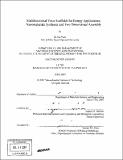Multifunctional virus scaffolds fore energy applications : nanomaterials synthesis and two dimensional assembly
Author(s)
Nam, Ki Tae
DownloadFull printable version (31.15Mb)
Other Contributors
Massachusetts Institute of Technology. Dept. of Materials Science and Engineering.
Advisor
Angela M. Belcher.
Terms of use
Metadata
Show full item recordAbstract
Biological systems inherently posses the ability to synthesize and assemble nanomaterials with remarkable precision, as evident in biomineralization. These unique abilities of nature continue to inspire us to develop new approaches of nanobiotechnology to integrate advanced materials into medicine and electronics. Particularly, peptides are believed to play an important role in biotemplating and biological self-assembly. In order to understand the interface between inorganic materials and peptides and realize biological self-assembly, this work adopted M13 virus as a model system. The genetic engineering of M13 viruses enables us to grow various nanomaterials and achieve virus monolayer assembly on charged polyelectrolyte multilayers. The fundamental understanding and new discoveries obtained by this work can mature into an engineering discipline demonstrating that biological approaches may represent a new paradigm to provide novel technological advantages. The use of a biological template for a nanostructured battery electrode ramps up the device's performance and scales down its overall size. This work presents a new way of exploiting biological entities for the bottom-up assembly of battery devices by utilizing biological self-assembly and biotemplating. Viruses are genetically engineered such that they function as a toolkit for constructing the battery.
Description
Thesis (Ph. D.)--Massachusetts Institute of Technology, Dept. of Materials Science and Engineering, 2007. Includes bibliographical references.
Date issued
2007Department
Massachusetts Institute of Technology. Department of Materials Science and EngineeringPublisher
Massachusetts Institute of Technology
Keywords
Materials Science and Engineering.